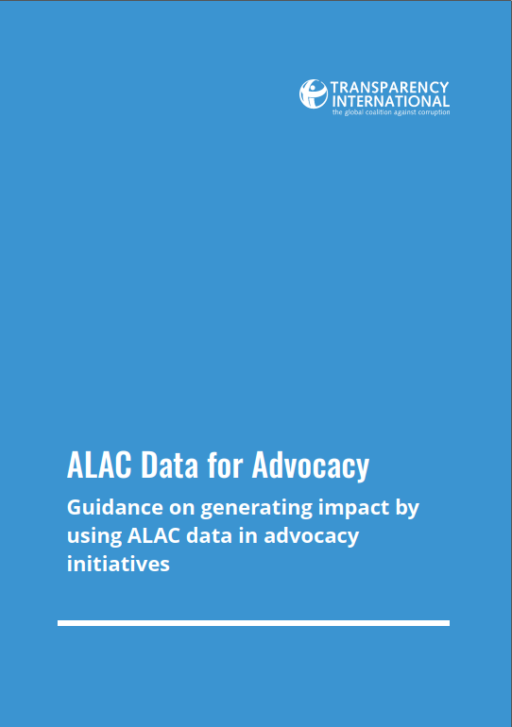- Home
- ALAC Data for Advocacy: Guidance on generating impact by using ALAC data in advocacy initiatives
ALAC Data for Advocacy: Guidance on generating impact by using ALAC data in advocacy initiatives
Description
Transparency International’s Advocacy and Legal Advice Centers (ALACs) empower people, communities and organisations to safely report corruption they experience or witness, and provide advice and support for individuals’ corruption related grievances. There are more than 95 ALACs in 64 countries, and, since 2003, over 300,000 people have contacted ALACs and more than 75,000 cases have been opened. The advice provided by ALACs is free, confidential and open to all. By providing simple, safe and viable mechanisms for people to actively reject corruption by seeking redress for wrongdoings, ALACs also are helping address issues of impunity.
As well as helping individuals, communities and organisations to pursue their corruption related complaints, the complaints received by the ALACs help identify trends, systemic weaknesses, or hotspots that allow corruption to flourish. These then are channelled into anti-corruption advocacy by Transparency International for systemic improvements. Transparency International also identifies emblematic cases and large corruption cases that may become the subject of corruption investigations and case-based advocacy.
Through our ALAC work, our Movement holds a unique goldmine of data about how corruption works in practice and how we have been able to combat it. We have many inspiring human interest stories showing this in practice, both on how corruption affects peoples’ lives and how people can – and have – stood up to it. Leveraging this data and these stories are crucial to engage in compelling, evidence-based advocacy, demonstrating that the cycle of corruption can be broken, that people can stand up to corruption, and to showcase to governments, citizens, donors and other stakeholders that our work has an impact.
This guide is meant to be used by Transparency International Chapters with an Advocacy and Legal Advice Centre (ALAC). The guide can be used by teams planning advocacy within the Chapter (executive directors, advocates, communications teams) as well as ALAC teams (such as, lawyers, ALAC coordinators).
Aims of this guide:
- Refresh key aspects of advocacy planning with a focus on how to use ALAC data when planning and implementing advocacy actions.
- Support chapters to analyse and use ALAC data (based on the ALAC Database) for advocacy purposes. Through this, chapters are encouraged to determine which ALAC data fields are most relevant for their advocacy and then update their ALAC Database platform to collect data consistently on these fields.
- Provide examples of ALAC data frameworks that can help structure ALAC data analysis for advocacy, using the areas of: (a) corruption reporting trends; (b) institutional behaviour in processing/resolving ALAC cases and freedom of information requests; and (c) the Sustainable Development Goals (SDGs).
- Inspire chapters to use new and innovative ways to advocate using ALAC data, through documenting a range of good practice examples from across the Transparency International Movement.
Caveat
The current version of the ALAC Data Guide does not yet include chapter case studies. These will be added to the document in due course.
Authors
Alison Matthews and Maria Sideri
Reviewers:
Anoukh de Soysa, Marie Laberge, Transparency International Sri Lanka
Date
03/11/2023
Tags
 Download PDF
Download PDF
